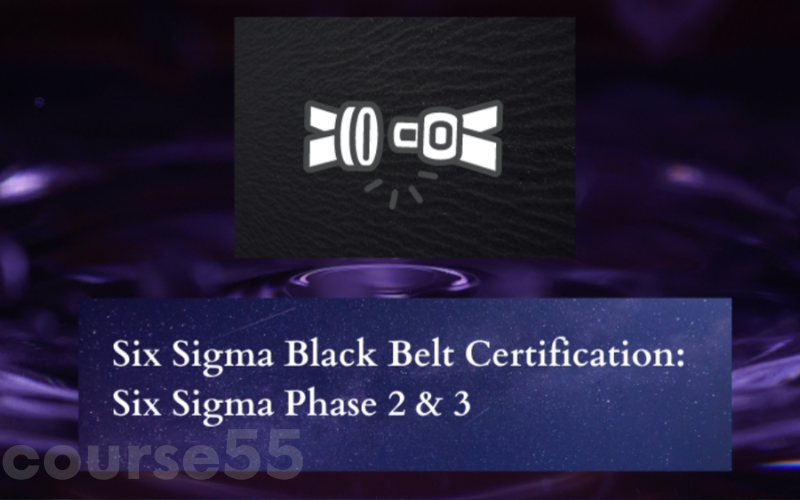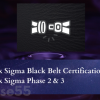Six Sigma Black Belt Certification: Six Sigma Phase 2 & 3 By Stone River eLearning
$99.00 $15.00
Review of Six Sigma Black Belt Certification: Six Sigma Phase 2 & 3 by Stone River eLearning
Content Proof:
In an era marked by relentless competition and a perpetual push towards operational excellence, the significance of methodologies like Six Sigma cannot be overemphasized. The Six Sigma Black Belt Certification: Phase 2 & 3 course by Stone River eLearning functions as a pivotal stepping stone for professionals eager to harness the power of data-driven decision-making.
This course meticulously explores two crucial phases Measure and Analyze where participants delve into the intricacies of process improvement. It aims not only to impart technical knowledge but to foster a mindset curious about finding root causes of inefficiencies that can stifle an organization’s growth. Through insightful discussions, practical tools, and engaging methodologies, learners leave equipped with a foundation strong enough to support transformative developments in their workplaces.
Phase 2: Measure
The Measure phase of Six Sigma is akin to the foundation of a grand building; without a robust foundation, the entire structure is destined for failure. Here, learners are introduced to essential concepts and tools that guide the data collection process, ensuring the measurement of quality and efficiency in operations. A central focus of this phase is the Cost of Poor Quality (COPQ), an eye-opening metric that quantifies the financial impact of defects and inefficiencies. Understanding COPQ enables professionals to make compelling business cases for improvement initiatives, casting light on the often unseen costs that weigh heavily on profit margins.
Furthermore, process mapping emerges as a vital component within the Measure phase. Utilizing tools like the Value Stream Map (VSM) allows learners to visualize the flow of information and materials through the production process, identifying glaring inefficiencies that can hinder performance. As practitioners become adept at mapping processes, they can also apply the 8 Wastes framework to recognize and eliminate areas of waste, thus fostering a culture of continuous improvement.
The curriculum emphasizes developing data collection plans and Measurement System Analysis (MSA), which scrutinize whether the data gathered can reliably inform process improvements. Additionally, a profound understanding of process capability emerges as a cornerstone when dealing with both discrete and continuous data. The tools and techniques introduced in this phase serve as a playbook for assessing current performance levels, preparing participants for deep analytical work in the next phase.
Key Topics in Phase 2: Measure
- Cost of Poor Quality (COPQ)
- Process Mapping
- 8 Wastes Framework
- Value Stream Mapping (VSM)
- Data Collection Plans
- Measurement System Analysis (MSA)
- Process Capability Assessment
Phase 3: Analyze
Transitioning into the Analyze phase feels like stepping into a detective’s role where each clue, whether data point or trend, becomes a vital part of the investigation to uncover root causes of issues affecting quality and performance. Here, the course equips participants with various analytical tools pivotal for dissecting problems with surgical precision. Among these tools, the Fishbone Analysis and the 5 Whys Technique are particularly noteworthy. These methods encourage a structured exploration of problem areas, leading participants to the underlying causes rather than mere symptoms.
The Pareto Analysis, another essential tool, introduces the 80/20 rule, highlighting that a small percentage of causes often leads to a large percentage of problems. This kind of insight is invaluable in a world where time and resources are finite; optimizing efforts towards the most significant issue can yield exponential returns. Moreover, the inclusion of various statistical testing methods enriches participants’ abilities to perform hypothesis testing a core requirement for validating improvement initiatives scientifically.
To further empower learners, graphical methods such as scatter plots and box plots are reviewed throughout this phase. These visual tools enhance the ability to interpret complex data sets, revealing hidden trends and disparities that can inform effective decision-making. By blending quantitative data with intuitive visualizations, the Analyze phase prepares participants not only to identify issues but also to advocate for thoughtful, data-backed solutions within their organizations.
Key Topics in Phase 3: Analyze
- Fishbone Analysis
- 5 Whys Technique
- Pareto Analysis
- Statistical Testing Methods
- Hypothesis Testing
- Graphical Methods (Scatter Plots & Box Plots)
Practical Applications of Six Sigma Methodologies
The overall goal of the Six Sigma Black Belt Certification course by Stone River eLearning transcends mere knowledge acquisition; it cultivates a set of practical skills directly applicable in the workplace. Each phase, Measure and Analyze, is conscientiously designed to build a comprehensive toolkit that participants can employ for driving meaningful change in their respective organizations. The emphasis on actionable insights is akin to crafting a well-oiled machine, where each component functions harmoniously, resulting in optimized performance.
Upon completing this course, participants emerge not only prepared for certification but also equipped to lead initiatives that can ripple out across their organization. This dual focus on academic rigor and practical application ensures that learners can wield their new skills confidently, enacting change that fosters a culture of excellence. An overriding theme from the course is the transformative power of applying a structured approach to problem-solving an invaluable asset in today’s fast-paced business environments.
Benefits of Completing the Certification Course:
- Enhanced Analytical Skills
- Mastery of Key Six Sigma Tools
- Improved Decision-Making Abilities
- Capability to Drive Process Improvements
- Preparation for Certification Exam
Conclusion
The Six Sigma Black Belt Certification: Phase 2 & 3 course from Stone River eLearning represents an essential opportunity for professionals seeking to deepen their expertise in process improvement methodologies. By focusing on the Measure and Analyze phases, it provides a solid foundation for any professional aiming to refine their analytical skills while tackling inefficiencies within their organizations. Through a structured framework and a wealth of practical tools, learners are not merely prepared for certification; they are transformed into agents of change capable of pioneering excellence within their fields.
In a fast-evolving business landscape, nurturing these skills not only enhances career prospects but also contributes to organizational success. By investing in this course, you may just be the catalyst that your organization desperately needs to thrive in today’s competition.
Frequently Asked Questions:
Business Model Innovation: We use a group buying strategy that enables participants to share costs and access popular courses at lower prices. This approach helps individuals with limited financial resources, although it may raise concerns among content creators regarding distribution methods.
Legal Considerations: Our operations navigate complex legal issues. While we do not have explicit permission from course creators to resell their content, there are no specific resale restrictions mentioned at the time of purchase. This lack of clarity allows us to offer affordable educational resources.
Quality Control: We guarantee that all course materials provided are identical to those offered directly by the creators. However, please note that we are not official providers. As a result, our services do not include:
– Live coaching calls or sessions with the course author
– Access to exclusive author-controlled groups or portals
– Membership in private forums
– Direct email support from the author or their team
Our goal is to make education more accessible by offering these courses independently, without the additional premium services available through official channels. We appreciate your understanding of our unique approach.
Be the first to review “Six Sigma Black Belt Certification: Six Sigma Phase 2 & 3 By Stone River eLearning” Cancel reply
You must be logged in to post a review.


















Reviews
There are no reviews yet.